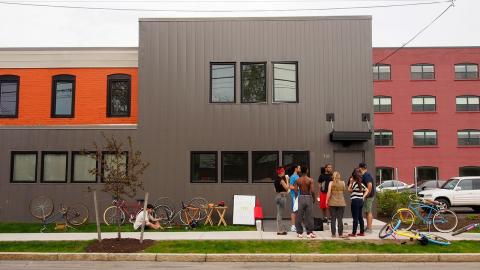The Near West Side Initiative (NWSI) is a community partnership involving Syracuse University, philanthropy, area residents, and civic leaders. Its goal for the disinvested area is fostering economic development, jobs, health, housing, and academic enrichment for both the university's students and those who attend the NWS's public schools. Art and culture play a key role in the priorities of the NWSI as well. Near West Side Initiative is engaged in:
Real estate development: NWSI-led commercial development efforts attracted anchor employers to site their operations in the neighborhood, including the regional PBS affiliate, WCNY, and the nonprofit organization ProLiteracy. NWSI also helped develop artist residences and mixed-use commercial and residential spaces, along with the cultural center La Casita. In addition, NWSI partner Home Headquarters, Inc., a nonprofit CDFI, offers homebuyer education, financial counseling, foreclosure prevention work, and real estate planning and development. HHQ created Opportunity Headquarters to provide construction apprentice training for low-income individuals for new and green housing. It is heavily involved in green development for the Near Westside.
Social enterprise: SALTWorks is a social enterprise focused on furniture design and woodworking, employing three Latino workers who graduate from Green Train, a workforce development program. After a three-month training program, participants are guaranteed a full-time job with living wages on the back end.
Health partnership: St. Joseph's Hospital Health Center opened the Westside Family Health Center and partnered through the NWSI with Nojaim Grocery and Syracuse Medical School to provide preventive, integrated care. The grocery store also boasts the presence of a community navigator, paid by NWSI grant through Annie E. Casey, who informs customers of social services, healthy food options, and community events. Health center patients can receive “prescriptions” for healthy food at the grocery, and are guided by the community navigator in obtaining subsidized whole foods, fruits, and vegetables.
Cultural vitality: NWSI regularly programs events like neighborhood game nights, competitions for light decorations, clean-up days, teacher appreciation nights, Thanksgiving dinners, holiday parties, multicultural block parties, and youth basketball tournaments. This is coupled with the creation of institutions like La Casita Cultural Center, a nonprofit dedicated to documenting and promoting Latino art in the area with dance workshops, reading circles for students, and a library. 601 Tully is another program that connects SU students with high school students while offering art classes, poetry series, and artist residencies.
Lessons for Community Wealth Building
Seek out unlikely coalitions and invest time in relationship building: Projects can develop with momentum, says, Marilyn Higgins, Syracuse University’s Vice President for Community Engagement and Economic Development. "When you don't ask the traditional people to solve the problem." The board was formed with the outspoken Father of a local church who "spoke the truth and wasn't afraid of confrontation." Over 25 people were assembled, including the local grocer, wealthy attorneys, developers, university deans, faculty members, and representatives from the public housing tenants association. "We spent a year having dinners and became such great friends in the process, which included analyzing documentaries on economic development and talking about it."
Prioritize the execution of a large demonstration project at the outset: One thing that was critical to the longevity of the project, says Higgins, is "getting people to do something physical, real and big. Otherwise it's just meetings and talk." The Lincoln Building was a vacant edifice in disrepair for decades and a symbol of decay in the neighborhood. Its redevelopment was inaugurated with a broad invitation in which everyone threw salt over their shoulders as a symbol of good luck, and six months later, NWSI celebrated its completion with a huge block party.
Focus effort around a manageable, place-based strategy: Maarten Jacobs, director of SALT, argues that targeting a neighborhood makes a new house or commercial building much more visible and generates a greater impact than more geographically ambitious efforts.
Long-term faculty and student investment can bridge the gown-town divide: Higgins discovered "early on" that the residents "love the students." The students who got engaged "had their clipboards and were designing houses and doing meaningful work," and residents “would come out and chat with them." Jacobs adds that faculty "who take semester or year-long or multi-year approach" get the students to "buy into that," which differentiates their problem-solving engagement from "picking up trash for the afternoon," which was a previous norm.
The art and cultural component should not be viewed as window dressing for community revitalization: "To me it's been fascinating to watch how much of a lubricant it has been," says Marilyn. "The books on poetry and photography, the public art piece, the bridge artwork—it was a great equalizer. It's huge."
High-level leadership involvement accelerates the process: Chancellor Nancy Cantor legitimized the project that moved it forward in a way that would have been impossible if comprised of solely deans, students and faculty. "To do this really well you need institutional clout behind these things," says Marilyn. "You don't get a 250,000-square-foot industrial warehouse redeveloped without it. Grants, money, foundations, and government agencies are more likely to give money that have the University associated with it, because they trust the quality of the work. Without significant amounts of money you can't do the things that show the difference."
